HOME Device - I/O Routing
The Device → I/O Routing tab appears if a device handles audio streams. It is used to map the audio channels of the IP senders and receivers to the physical inputs and outputs of the device.
What is meant by the "physical inputs and outputs" varies depending on the device type. For example:
- For .edge, these are the inputs and outputs to the Audio Router option.
- For an A__stage, these are the local audio inputs and outputs: Mic/Line, AES3, MADI, etc.
- For HOME Apps, these are the inputs and outputs to the audio processing.
In each case, you can connect (or disconnect) the physical inputs to the IP sender channels, and the IP receiver channels to the physical outputs.
The examples in this topic show how to map the local audio I/O of an A__stage64. The same principles can be applied to other device types.
Opening the I/O Routing
Depending on how you want to view the information, there are three different ways to open the page.
- From the Device → Senders tab, select a stream and click on the I/O Routing option. This method shows all of the device inputs (on the left) and the stream's IP channels (on the right).
- From the Device → Receivers tab, select a receiver and click on the I/O Routing option. This method shows the receiver's IP channels (on the left) and all of the device outputs (on the right).
- Select the Device → I/O Routing tab. This method shows all available sources and destinations.
The first two methods are ideal for making assignments to a selected stream or receiver. You can select more than one stream or receiver if you wish. The third method is best if you need a complete overview of the device. The images below show two examples.
The first example shows the I/O Routing from the physical inputs of an A__stage64 to the selected sender:
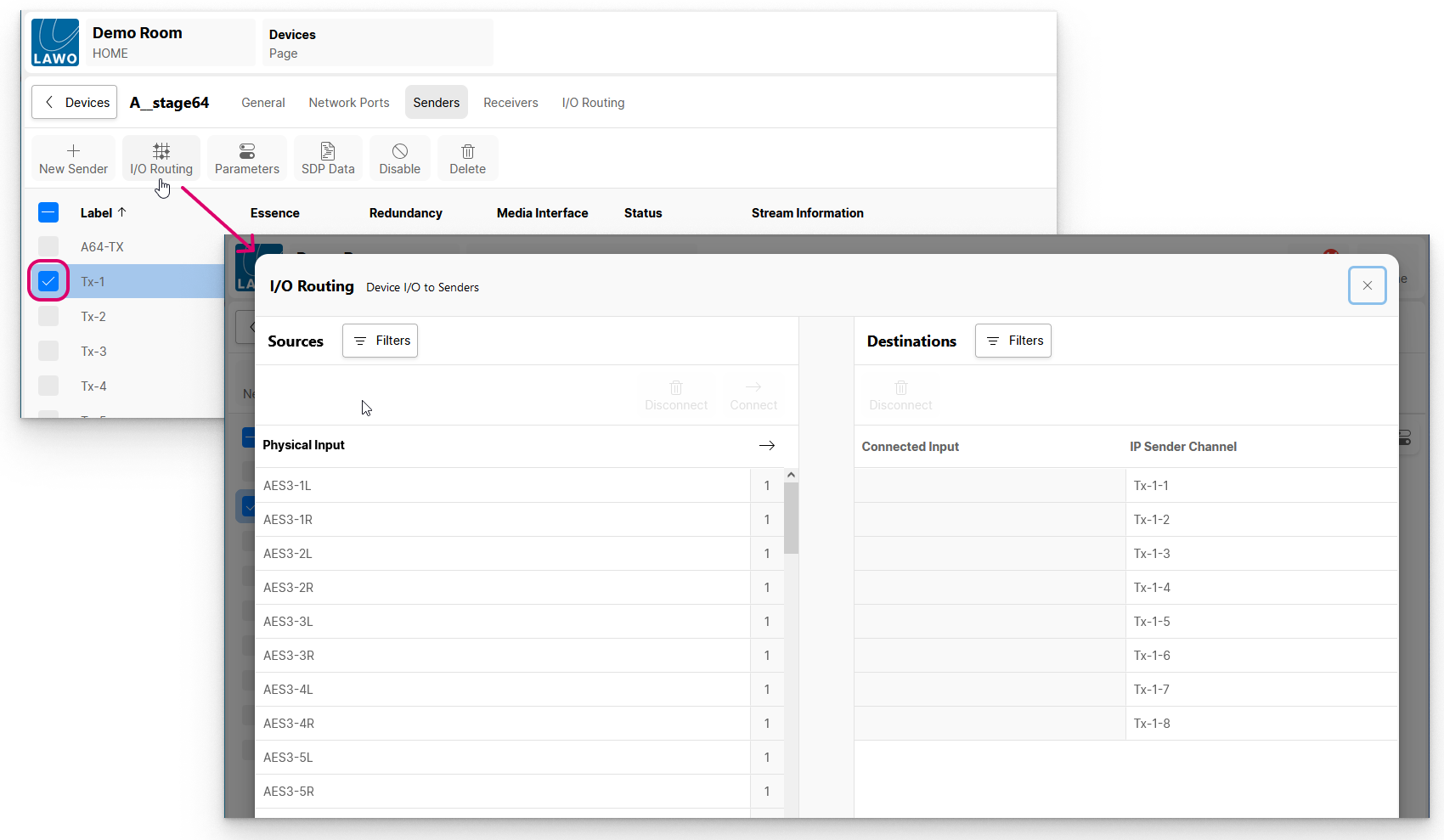
In the second example, you can check (and edit) all of the I/O Routing for the device.
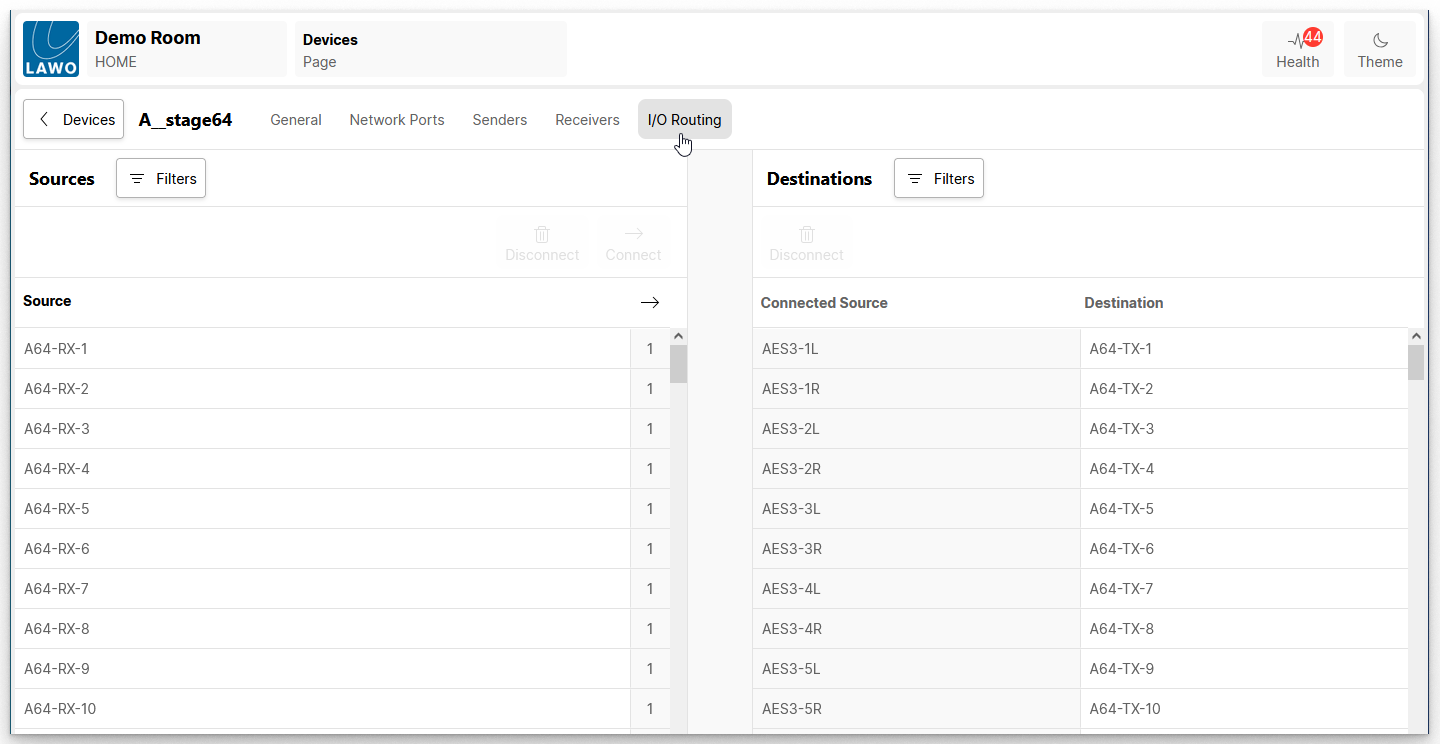
Once open, the page shows connections from "Sources" (on the left) to "Destinations" (on the right). Use the vertical scroll bars to scroll up and down each list.
- If a source is connected, then a number appears in the "source used" column. This indicates the number of connections made. i.e. the number of times a source is used.
- If a destination is connected, then the source label appears in the "Connected Source" column.
Editing the I/O Routing
The Connect and Disconnect buttons are used to make and break the connections (in the same manner as on the 'Stream Routing' page).
Apply a Filter
To restrict the view, you can apply one or more filters. This is a good idea, especially if you have opened the I/O Routing tab and have all sources and destinations in view.
1. Start by selecting the "Sources" Filters button and choose Filter by type.
2. Select the sources you wish to view (e.g. AES3 and MIC/LINE).
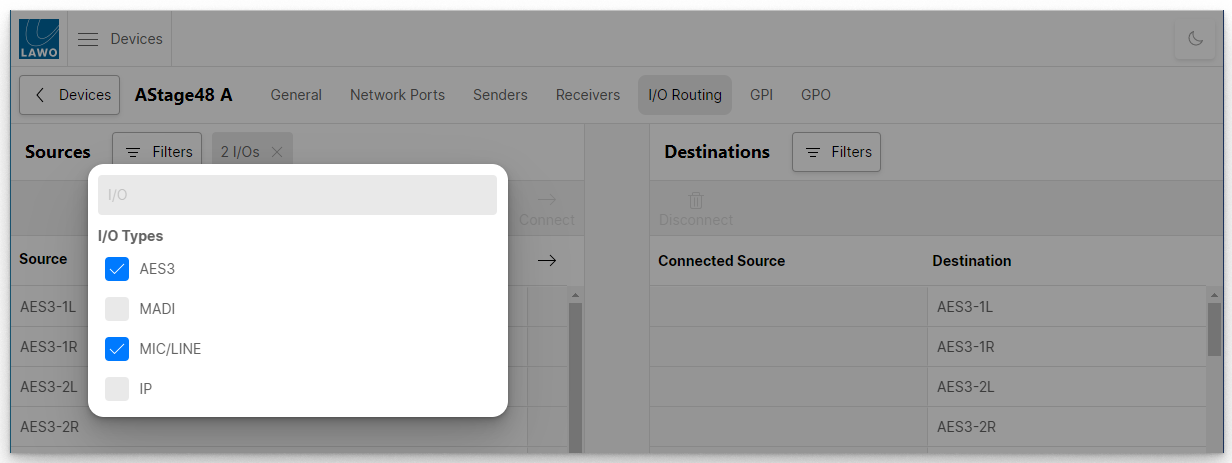
3. Click anywhere outside of the Filters box - the pop-up closes and the filters are applied.
4. Repeat to filter the "Destinations", but this time choose IP.
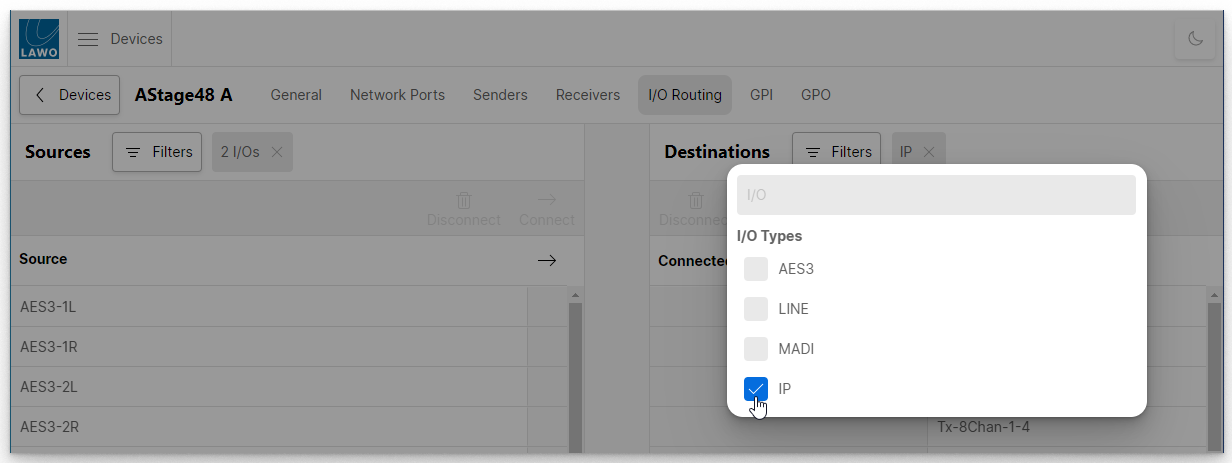
You should now see all of the AES3 and Mic/Line inputs (on the left) and IP channels (on the right). This view is ideal for connecting the physical inputs of the device to the IP channels of the sending streams.
Connect a Source to a Destination
To prepare a connection, select a source and a destination - the selections are highlighted (in blue) and a dotted (preview) line appears.
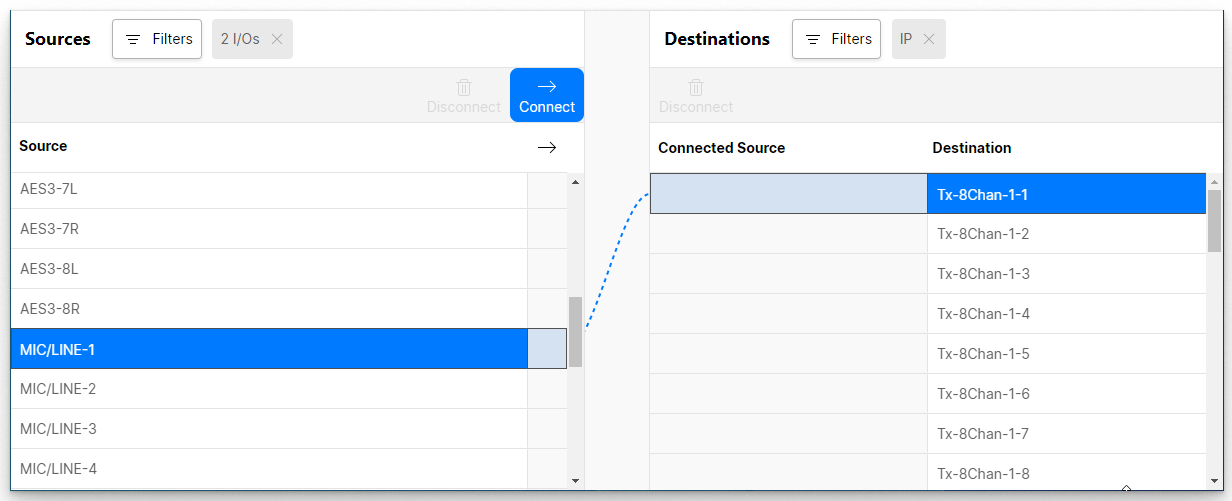
To make the connection, click on Connect - the dotted (preview) line changes to a solid line and the "Connected Source" field updates.

Using Disconnect
To break a connection, select either a source or destination and click on Disconnect.
- If you disconnect a source, then all of its connections are removed and the "source used" field clears.
- If you disconnect a destination, then only the one connection is removed and the "Connected Source" field clears.
Using Multi Select
It is possible to make (or break) several connections in one operation by selecting multiple sources and destinations.
To select a range:
- Click on the first source (or destination).
- Press and hold SHIFT (on your keyboard) and click on the last source (or destination).
- The selections highlight in blue.
- If you press and hold SHIFT again, you can increase or decrease the selected range.
To select non-consecutive sources or destinations:
- Either press and hold CTRL (on your keyboard) or turn on the Multi Select option (at the bottom of the page).
- Click on the individual sources or destinations.
- The selections highlight in blue.
- If a range is selected, you can use this method to remove or add entries to the range.
When you click Connect (or Disconnect), the assignments are made in one operation. For example, to connect eight sources to eight destinations.
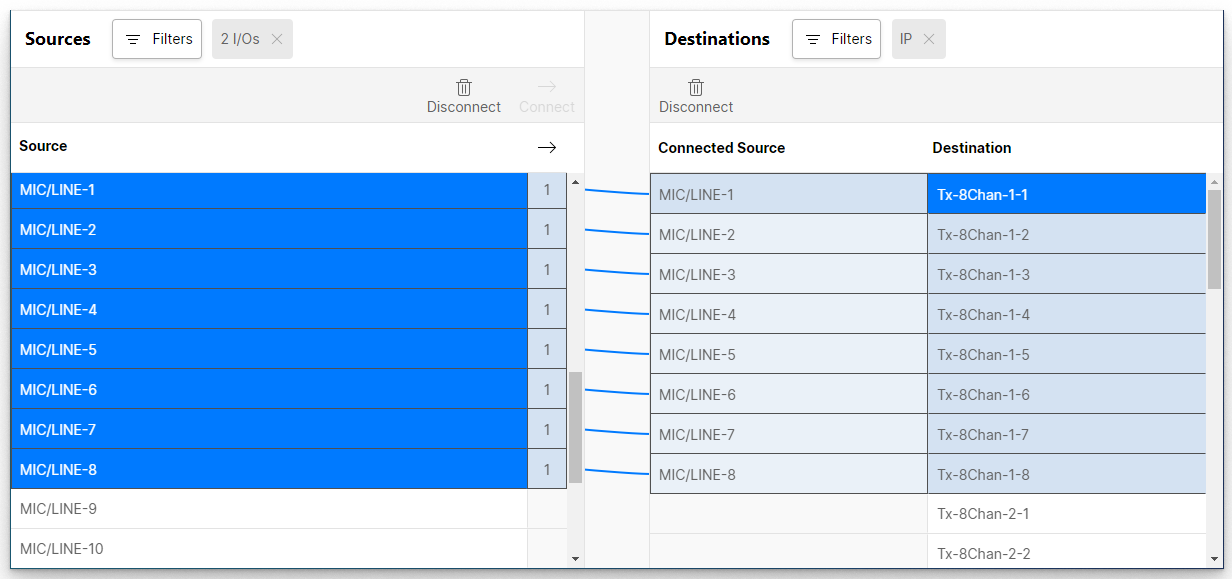
If there is a mismatch between the number of selected sources and destinations, then the sources are assigned consecutively to the available destinations on a best-effort basis. For example:
- If there are eight sources and only four destinations, then the first four sources are connected consecutively to the first four destinations.
- If there are two sources and eight destinations, then the sources are connected (left/right) to each pair of destinations (as shown below).
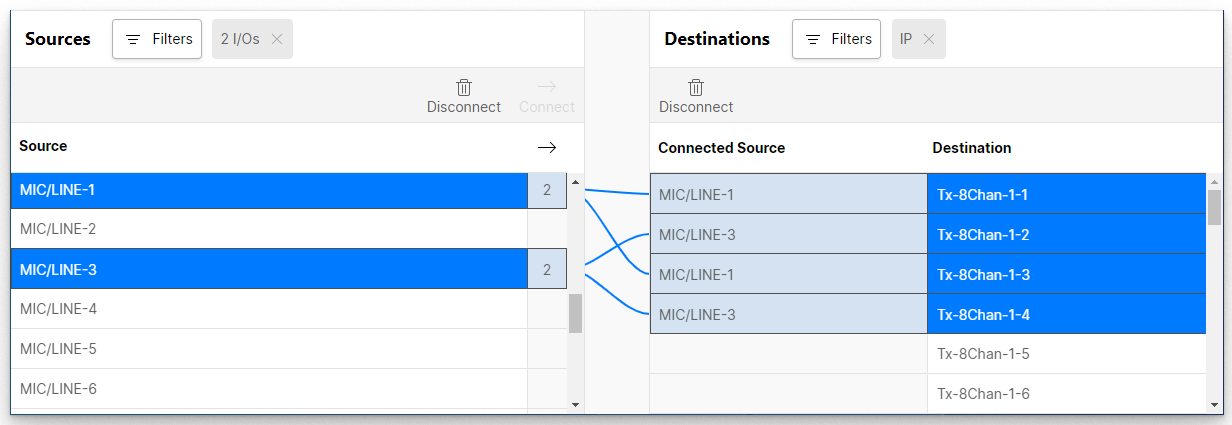
Clear Selections
The quickest way to clear the current selections is to use the n Item(s) Selected buttons (at the bottom of the page).
There is one button for each list: Sources and Destinations. In each case:
- The button shows how many sources (or destinations) are selected.
- You can clear all of the current selections by clicking on the X.
Reverse the Filters
Remember to reverse the filters to connect the receiver's IP channels to the device's physical outputs.